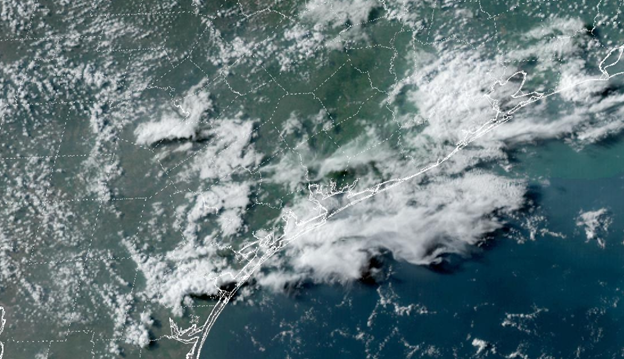Tracking precipitation features and associated large-scale environments over southeastern Texas
Submitter
Fast, Jerome D
— Pacific Northwest National Laboratory
Area of Research
Cloud-Aerosol-Precipitation Interactions
Journal Reference
Liu Y, Y Qian, L Berg, Z Feng, J Li, J Chen, and Z Yang. 2024. "Tracking precipitation features and associated large-scale environments over southeastern Texas." Atmospheric Chemistry and Physics, 24(14), 10.5194/acp-24-8165-2024.
Science

A study characterizes spatiotemporal patterns of convective systems over southeastern Texas, highlighting the roles of large-scale patterns in different types of convection initiation and propagation. Photo courtesy of GOES Image Viewer.
Deep convection is a major contributor to annual total precipitation and a source of very high-intensity rainfall over coastal Texas. Understanding the initiation and development of deep convection, including isolated deep convection (IDC) and mesoscale convective systems (MCSs), is crucial due to their significant impact on regional weather patterns and extreme weather events. Previous studies have shown that MCSs, which are large and long-lasting convective systems, contribute substantially to total precipitation, particularly in the form of extreme events. In contrast, IDC events are shorter-lived and more localized but still play a critical role, especially during the summer and fall seasons. The initiation of these convective systems is influenced by a combination of large-scale meteorological patterns and local factors, such as urbanization and sea breezes.
Southeastern Texas, including the Houston metropolitan area, experiences frequent and intense convective storms due to its proximity to moisture sources like the Gulf of Mexico and its exposure to varying synoptic processes, such as the Bermuda High and the Great Plains low-level jet. These systems can influence the initiation of the convective cells and alter their trajectories.
This study aims to characterize MCSs and IDC under various meteorological patterns and to understand how those patterns affect convection initiation and propagation across different seasons. Using 13 years of high-resolution observations and reanalysis data, the research analyzes the spatiotemporal patterns of MCSs and IDC over southeastern Texas. By employing self-organizing maps and the tracking algorithm, we identify the key meteorological patterns associated with these convective events and investigate the statistics of those tracked cells, providing valuable insights into their initiation, development, and impact on regional precipitation.
The implications of this study are significant. Understanding the role of large-scale environments helps distinguish the impact of local factors on convection initiation and development. The findings offer guidance for selecting cases where local factors dominate, improving strategies for weather prediction and climate adaptation in southeastern Texas.
Impact
This study reveals that MCSs significantly contribute to both mean and extreme precipitation across all seasons in southeastern Texas, while IDC plays a crucial role during summer and fall. MCSs contribute to approximately 67% of the mean precipitation in spring, 33% in summer, 41% in fall, and 47% in winter. IDC contributes to 14%, 32%, 19%, and 15% of mean precipitation during spring, summer, fall, and winter, respectively, over the coastal Houston metropolitan area. The analysis also shows that both MCS and IDC initiation are predominantly influenced by large-scale lifting and low-level moisture convergence during spring, fall, and winter. In contrast, summer convection can be triggered even under weak large-scale circulation anomalies due to strong surface instability and abundant moisture. MCSs are found to frequently initiate west of Houston, travelling eastward for ~eight hours to southeastern Texas. MCSs also form three hours earlier on average during frontal conditions than those during anticyclones. The study's implications highlight the importance of understanding the distinct roles of large-scale meteorological patterns and local factors in convective initiation and development. By isolating the impact of large-scale environments, the findings offer guidance for selecting cases where local factors dominate.
Summary
This study investigates the characteristics and spatiotemporal patterns of convective systems over southeastern Texas using 13 years of high-resolution observations and reanalysis data. By focusing on MCSs and IDC, the research highlights their contributions to seasonal and extreme precipitation. Using self-organizing maps to categorize large-scale meteorological patterns and a tracking algorithm to monitor the life cycle of MCSs and IDC, the study provides a comprehensive analysis of these systems. The findings emphasize the importance of understanding the distinct roles of large-scale meteorological patterns and local factors in convective initiation and development.
Keep up with the Atmospheric Observer
Updates on ARM news, events, and opportunities delivered to your inbox
ARM User Profile
ARM welcomes users from all institutions and nations. A free ARM user account is needed to access ARM data.


















